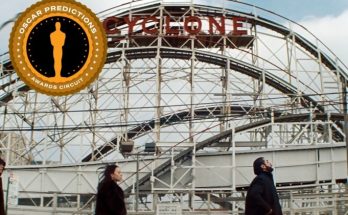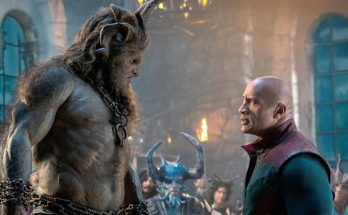Those arena sharks are just one of many anachronisms, but the bigger problem with the film is its portrayal of the new rulers. Despite their casting as pasty strawberry blondes, for instance, the real-life counterparts of Caracalla and Geta were sons of an African Roman emperor named Septimius Severus and a Syrian woman named Julia Domna. The film has its fun in casting aspersions on the masculinity and leadership abilities of these fraternal rulers by cladding them in lavish colors and thick cosmetics and accessorizing them with jewelry and even a pet monkey. It misses out, however, on the opportunity to explore the fascinating, colorful, and syncretistic world of the real Severans being reconstructed by art historians and artists today.

Before we can understand how these two Afro-Syrian brothers came to power, we must return to the demise of Commodus. In the first Gladiator, the former general and then enslaved gladiator Maximus Decimus Meridius (Russell Crowe) kills the evil emperor Commodus (Joaquin Phoenix) as 50,000 Romans watch in the Colosseum. In reality, Commodus, Marcus Aurelius’ son, was killed by a youthful athlete named Narcissus in 192 CE. The assassin strangled the ruler while he was in a bath in his house on Rome’s Caelian Hill.
By that time, it had been almost ten years since the real Commodus killed his sister, Lucilla, in 182 CE. In the movie version, however, Lucilla (Connie Nielsen) remains alive, playing the long-suffering mother of Lucius (Paul Mescal), the hero of Gladiator II. In Roman history, the period of uncertainty after Commodus’ demise was called the “Year of the Five Emperors.” Ultimately, it was a Roman governor of Punic and Italian origins named Septimius Severus who marched on the city of Rome with the support of the Roman legions from along the Rhine and Danube rivers, becoming the new emperor. His second wife, Julia Domna, was the wealthy daughter of a priest from Emesa in present-day Homs, Syria. When the Severan Dynasty came to power in 193 CE, the couple already had a pair of sons: five-year-old Caracalla and four-year-old Geta. In the film, the two are depicted as twins, and their father is not seen at all.
Not only does the African emperor not make it to the screen in Gladiator II, but the Africans that are depicted play the role of barbaric outsiders in ways both problematic and familiar. Lucius, who goes by the Phoenician name Hanno, was raised to hate Rome in the African province of Numidia. Despite his upbringing, Lucius eventually reveals that he is a Virgil-quoting Roman only hiding in the garb of an African. Numidia and other such provinces such as Africa Proconsularis are characterized as rebellious and non-Roman from the opening scenes of the movie, during which an uprising is put down by the Roman general Marcus Acacius (Pedro Pascal). This, even though they had by then been part of the Roman Empire for many centuries, and a great number of wealthy Roman families were living within them.

The most allegedly progressive casting for the movie was Denzel Washington as the African usurper Macrinus, a gladiator troupe owner and power broker. The real Macrinus was a Mauritanian and a praetorian prefect from a wealthy family of elite Roman equestrians originally based in what is now Algeria. Scott’s Macrinus, though, is no equestrian elite, but rather an ambitious nouveau-riche who trades in gladiators, slaves, and soft power. Instead of depicting Macrinus as the wealthy African from an established Roman family that he is, Scott chooses to depict Macrinus as an upstart and — as it is revealed later — a formerly enslaved person.
One of the only attempts in the film to address Rome’s oppressive use of enslaved labor comes in the last bloody moments of the jumbled plot. Finally revealing his background, Macrinus tells Lucius that he was once enslaved by Marcus Aurelius, a nod to the fact that emperors enslaved hundreds of people as part of the familia Caesaris, or “family of Caesar.” Not long after, Macrinus kills Geta and eventually Caracalla as well, seizing power. The triumphal Macrinus now stands in the hallowed halls of the Roman Senate House as the acclaimed emperor. And yet, Macrinus’ former servitude and ire toward Marcus Aurelius goes unexplored.
This was yet another missed opportunity for Macrinus, and by extension, Scott and the film writ large, to speak up about the real Marcus Aurelius. Just as he was in the previous film, Aurelius continues to be extolled, quoted, and aesthetically referenced in sculpture due to the ahistorical notion that he wanted to rid Rome of imperial succession and return to the Republic that existed before Julius Caesar. Although the emperor has enjoyed much celebration by wealthy technocrats obsessed with quoting Stoic virtues from the emperor’s Meditations, the real Marcus Aurelius was a man who chose his own biological son, Commodus, to take over as Roman Emperor. This broke with over 80 years of emperors adopting more fitting rulers to take over the Roman Empire during the course of the second century CE. He put family before community in a way neither Gladiator or Gladiator II ever reckons with. And he did so while adopting a Stoic philosophy that promotes being happy with one’s lot in life and not focusing on wealth. This is a much easier thing to do when one is born an emperor rather than a slave.

In other ways, African identity is glossed over altogether in Gladiator II — the Afro-Syrian lineage of Geta and Caracalla is never addressed. The brothers’ family is non-existent. Archaeological remains tell a different story. Perhaps the most famous depiction of the emperor, his wife, and his children comes from a painted tondo dated to around 199–200 CE made about seven years into Septimius Severus’ reign and found in Djemila in present-day Algeria. The tondo allows for more insight into the variant skin tones within the Roman Mediterranean and further investigation into what the Severans looked like in real life.
The famed portrait is not the only evidence that allows us to access how the Severans looked. Leading art historians and artists are now working with the Sidney and Lois Eskenazi Museum of Art at Indiana University to try and reconstruct the Severans using the vestiges of ancient polychromy left on two busts of Septimius Severus and Julia Domna in the museum collection. Working with Mark Abbe, an Associate Professor of Art History and Classics at the University of Georgia and a leading polychromy scholar, and Stephen Chappell, an independent digital artist, the museum is using new microscopic analyses of the remaining colorants on the museum’s busts in order to suggest a number of possible reconstructions for Severus and Domna. The busts and multiple possible reconstructions sit side-by-side in the gallery. A new publication, Imperial Colors: The Roman Portrait Busts of Septimius Severus and Julia Domna (2023), reveals these new reconstructions while also showing how Septimius Severus and Julia Domna used references to Egyptian gods like Serapis and Isis to accentuate the fact that they “had one foot planted in Africa and the other in Rome.”

Demonstrating that wealthy Africans served as Roman senators, magistrates, and respected citizens in imperial Rome long before (and many years after) the Severans came to power dissolves the casting of Africa and Africans in Gladiator II as largely rebellious, uncivil, and above all, outside of the bounds of the Roman empire. In comments to Hyperallergic, archaeologist and Classics professor Vivian Laughlin also discussed the importance of using these reconstructions to teach students about the diversity of the Roman Mediterranean. “Scientific analysis of the hue of his skin can negate the preconceived notion that just because Severus was a Roman Emperor, he must have appeared European, without any melanin,” Laughlin remarked. Showing students that skin tone and Africanness did not hinder political position continues to chip away at the modern assumption about Rome’s Whiteness.
Septimius Severus eventually died in February of 211 CE, leaving his sons to co-rule for less than a year. Despite their father’s alleged last words urging them to get along, Caracalla would have his brother, Geta, killed later that year. Caracalla then served as emperor alone for almost six more years thereafter, before the praetorian prefect Macrinus would have him murdered by a soldier. The Syrian mother of the brothers, never depicted or referenced in the film, would not die until 217 CE in Antioch (Turkey) in the same year as her son. Caracalla’s 14-year-old cousin from his Syrian side, a teenager named Elagabalus, would then bring the Severan dynasty back to power, followed by a final Severan named Severus Alexander. Despite never being addressed in the film, the Afro-Syrian parentage of Geta and Caracalla is crucial to Roman history: It remained an important part of the public art and coinage produced by the Severan dynasty until its fall in 235 CE. What pained me the most about Gladiator II was not the many anachronistic or ahistorical gaffes that ranged from references to hoses, newspapers, and sharks in the Colosseum to inscriptions in both English and Latin — it was the damage done by perpetuating false ideas about Africa and Rome’s supposedly “good” emperors.
Films don’t have to be historically accurate to be good or enjoyable. I still rewatch Spartacus (1960) every year, despite its historical flaws. But movies set in historical time periods do wield an undeniable public power — and thus responsibility. As I gaped at the white marble of the famed Apollo Belvedere, which made a brief cameo in the third act of Gladiator II, I wanted more than just painted statues or colorful architecture to be visualized for the audience. Omission can cause more damage than inaccuracy. Ignoring the Afro-Syrian identity of Geta and Caracalla in both casting and in plot, all while also erasing women like Julia Domna altogether, reinforces the popular assumption that Rome’s diversity lay only in the outlying places it conquered. Instead, we can and should recognize that it also existed among the elite Romans doing the conquering.




